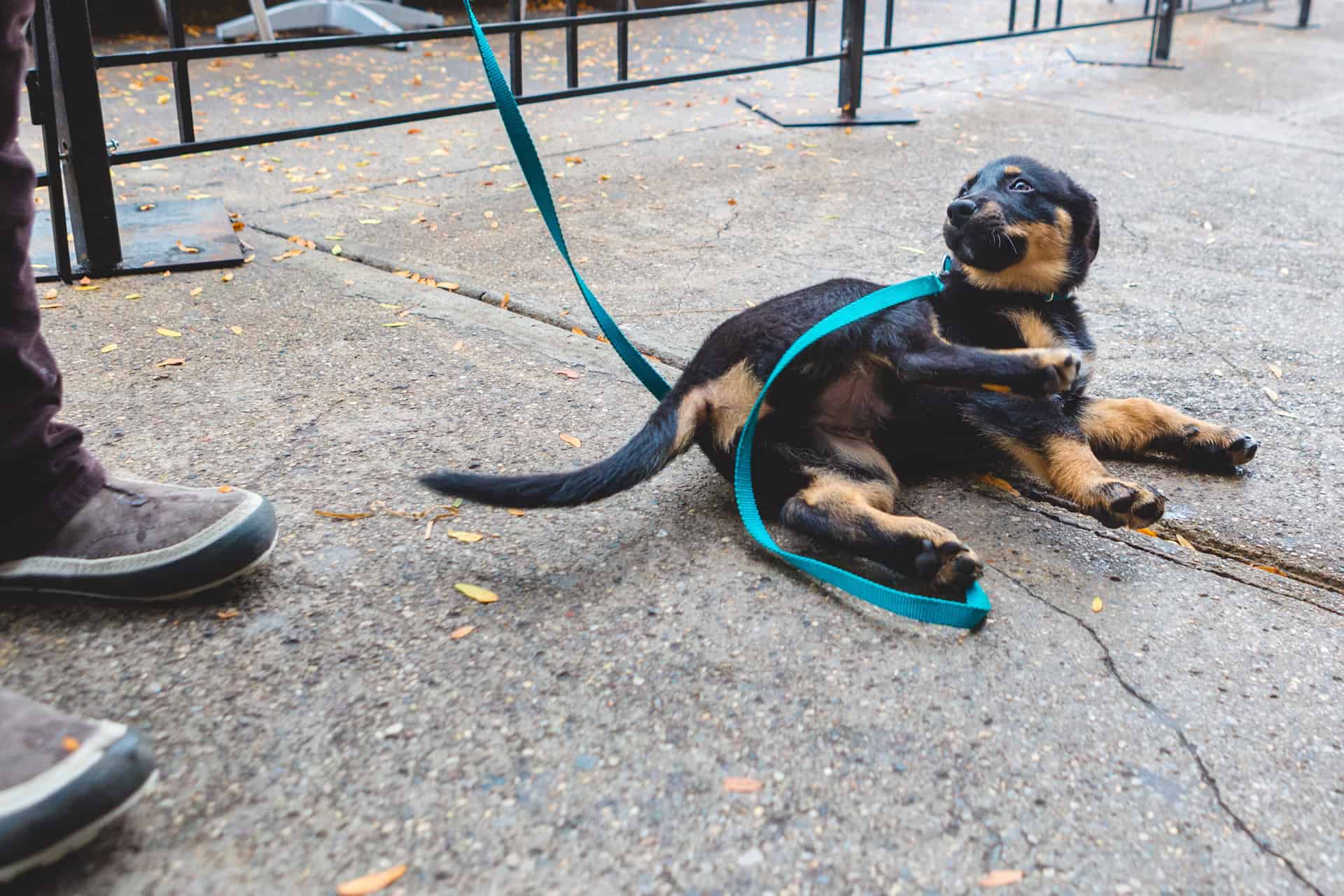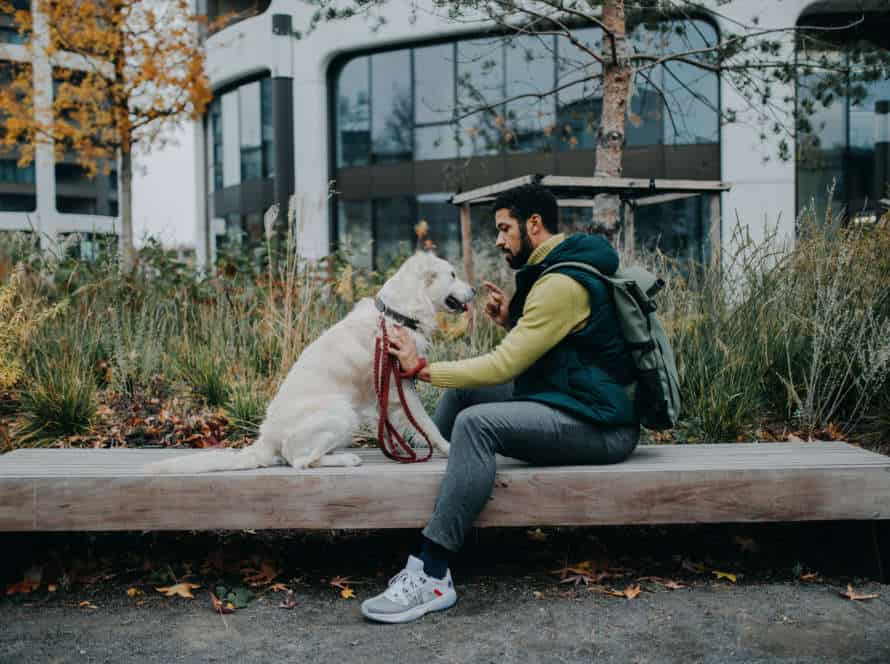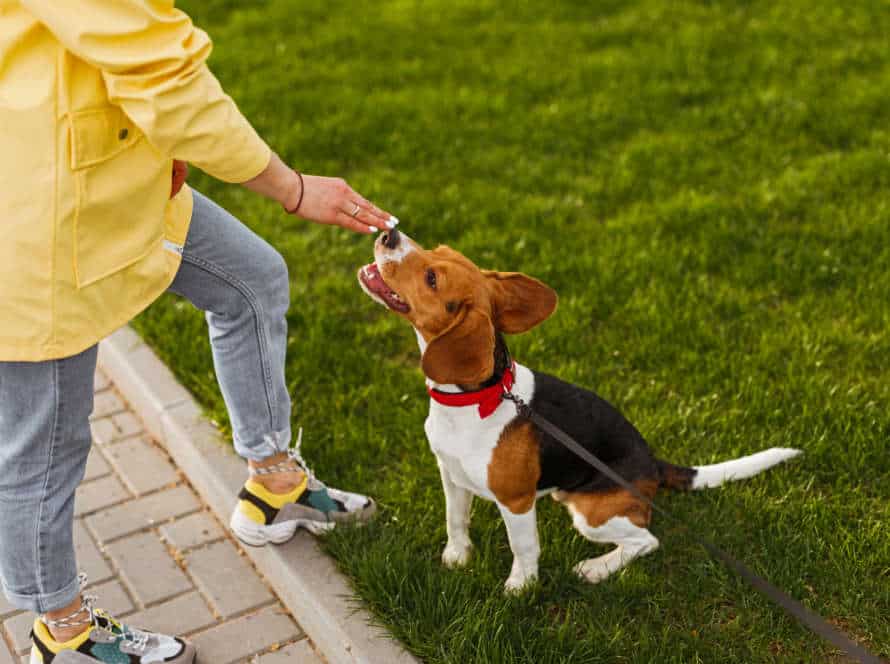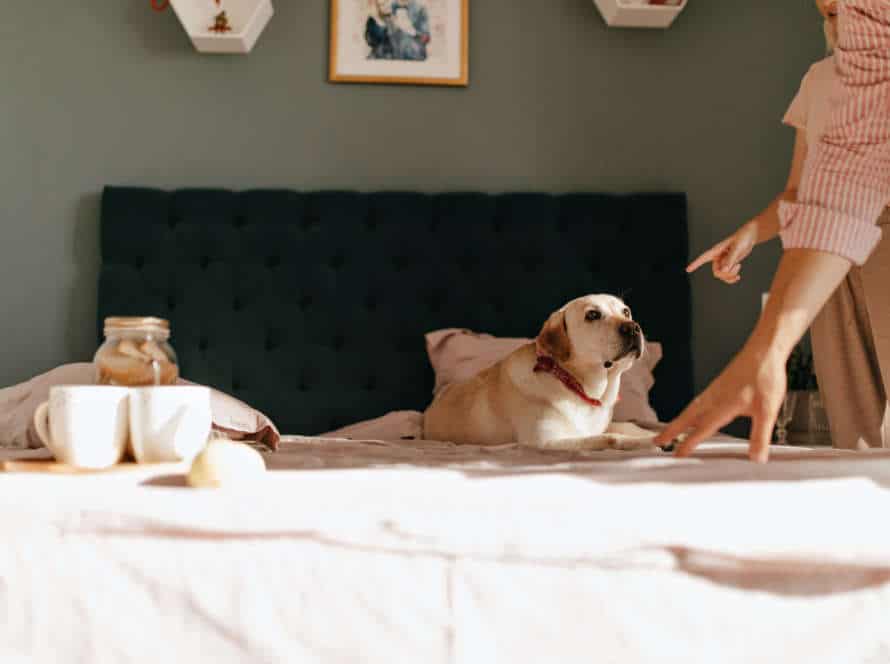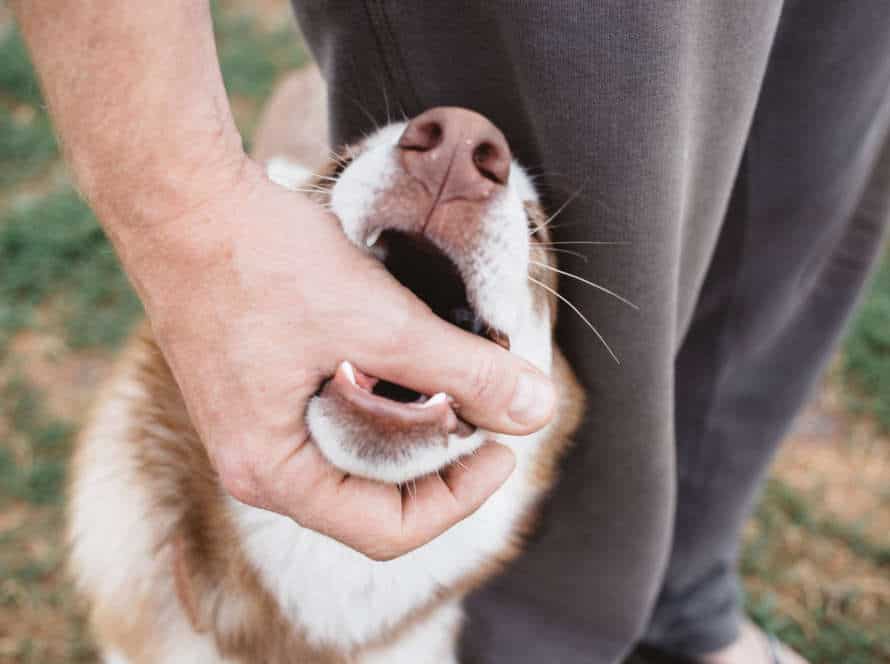How to Prevent Leash Reactivity in Puppies and Adult Dogs
Leash reactivity in puppies and adult dogs is a common behavior. You can prevent it with the right techniques and training. Here are some helpful tips:
- Socialize your pup with other dogs and people from an early age. This makes them feel secure.
- Use positive reinforcement to teach proper leash walking. Reward good behavior with treats or praise.
- Don’t punish or use negative reinforcement. This won’t help and can harm the trust between you two.
- Use a front clip or no-pull harness to control your dog’s movements.
- If needed, work with a professional dog trainer or behaviorist to address any anxiety or fear causing the reactivity.
By following these tips, you can help prevent leash reactivity and have a happy, relaxed walk with your pup!
Understanding Leash Reactivity
Leash reactivity happens when a pup or adult dog reacts aggressively or fearfully to other pooches or people – while on a leash. Walks and trips with doggos can become very stressful because of this. To stop it from happening, it’s important to figure out the cause.
Here we’ll discuss the causes and ways to reduce leash reactivity in puppies and adult dogs.
Causes of Leash Reactivity
Leash reactivity in dogs is a common problem. It can be caused by various factors. These include lack of socialization, fear, anxiety and even medical issues.
- Lack of socialization can make dogs feel scared in new situations and result in aggressive behavior on a leash.
- Fear and anxiety due to bad past experiences or abuse can also lead to leash reactivity.
- Medical issues like pain or discomfort can make dogs associate it with other dogs or people, resulting in leash reactivity.
It’s crucial to use positive reinforcement to prevent leash reactivity. This includes proper socialization and training. Medical issues should be addressed, and the dog should be physically comfortable and feel safe.
Pro Tip: Consulting with a professional trainer or behaviorist can help you understand the root cause of your dog’s leash reactivity and create a personalized plan for it.
Common Signs of Leash Reactivity in Dogs
Leash reactivity is a problem for many dogs. It can lead to barking, lunging, growling, and even aggression. Here are some signs of leash reactivity:
- Pulling on the leash
- Stiff body language
- Barking & lunging at others
- Hair standing up on the neck
- Dilated pupils & intense stares
- Whining, growling, or snapping
Luckily, there are ways to prevent this. Positive reinforcement training, desensitization exercises, and a front-clip harness can help.
Why Leash Reactivity is Dangerous
Leash reactivity can be risky for both pups and their handlers. Dogs displaying leash reactivity often lunge, bark, and act aggressively towards other dogs or people while on a leash. This can cause physical discomfort and emotional distress to the reactive dog and those near them. Knowing the root cause of leash reactivity is essential to preventing and controlling it in puppies and adult dogs.
Here are some tricks to avoid leash reactivity in dogs:
- Socialize: Expose your dog to different people, animals, sounds, and environments to help them gain confidence and feel comfortable with new experiences.
- Positive Reinforcement Training: Reward your dog for good behavior to make them understand that obeying commands and responding to leash pressure is pleasant.
- Use Proper Equipment: Utilize the right leash and collar or harness to make your dog more comfortable and better controlled during walks, reducing the chance of aggression.
Remember, if your pup’s leash reactivity can’t be managed with these strategies, get professional help from a dog trainer or behaviorist.
Training Methods for Preventing Leash Reactivity
Leash reactivity? Not a problem! Training is the answer. Teach your pup better leash manners and address misbehaviors with several techniques. To prevent leash reactivity, use the right training methods. Ta-da! Problem solved!
Positive Reinforcement
Positive reinforcement is an effective way to stop leash reactivity in pups and adult dogs. It involves rewarding good behavior to encourage the dog to do it again in the future.
Here are some positive reinforcement techniques:
- Treat Training: Give treats when your dog stays calm on a leash. Give them treats when they act calmly around other dogs or people.
- Verbal Praise: Use a gentle and encouraging tone to let your dog know they’re doing well. Say things like “good job” and “well done” to reinforce good behavior.
- Clicker Training: Use a clicker to mark the exact time your dog behaves well. Then give them a treat or verbal praise.
Remember: Positive reinforcement needs to be used with consistency and patience when training your pooch. Tip – Be consistent and patient when training dogs for long-term results.
Counter Conditioning
Counter conditioning is a training technique used to stop leash reactivity in puppies and adult dogs. To achieve this, we change the pup’s negative emotion when it sees a trigger, to a positive one. Here’s how:
- First, identify the trigger that causes your pup’s leash reactivity.
- Second, introduce the trigger at a distance that won’t cause a reaction.
- Third, give your pup positive reinforcement (treats or praise) when they see the trigger but don’t react.
- Fourth, gradually decrease the distance between your pup and the trigger while continuing to offer positive reinforcement.
Repeat this process until your pup can be near the trigger without reacting negatively.
Be patient and consistent with this approach. It can take weeks or months to see progress. Pro Tip: Get help from a certified dog trainer to create a customized counter conditioning plan for your pup.
Desensitization
Desensitization is a helpful way to train pups and adult dogs to be less reactive on a leash. To start, recognize your dog’s triggers – things that make them bark, pull, or lunge while they’re leashed. Introduce the triggers in a controlled setting, beginning with low exposure and slowly raising it.
Provide positive reinforcement with treats and compliments when your pup remains cool around the triggers. Do this repeatedly, steadily increasing their exposure as they feel more comfortable. With time and persistence, your dog will link their triggers to pleasant experiences and no longer respond badly when leashed.
Proper Use of Leash and Collar
Leash reactivity can bring a load of worry! At home and on walks, it’s crucial to select the correct type of collar and leash. To prevent leash reactivity in puppies and adult dogs, let’s examine how to utilize the appropriate collar and leash.
Types of Leashes and Their Uses
The right type of leash is key for preventing leash reactivity, proper training and control, and keeping your pup safe on walks. Here are some common leashes and their uses:
- Standard Leash: This is the most common type. They come in length, material, and thickness variances. Perfect for everyday use, training, and public walks.
- Retractable Leash: Popular for owners wanting more control over their pup’s movements. Allowing them to explore further but retracting when needed. Best used in open spaces, not crowded areas.
- Martingale Leash: Ideal for training and controlling aggressive dogs. Giving more control without choking. Adjustable and best for smaller-headed breeds like greyhounds or whippets.
- Harness: Suitable for puppies, small dogs, and those with breathing/trachea problems. Pressure distributed evenly across chest, making them great for pullers.
Choose the right leash to reduce leash reactivity in puppies and dogs. Get the right length, material, and thickness that fits you and your pup’s needs.
Pro tip: Train puppies and adults positively using treats and rewards!
Choosing the Right Collar
Choosing the right collar for your pup is a must for avoiding leash reactivity. This is especially true for puppies and adult dogs. Here are some to consider:
- Flat Collar – Lightweight and adjustable. Great for everyday use.
- Martingale Collar – For dogs with narrow heads, like Greyhounds or Whippets. It gently constricts the neck, so your pooch can’t escape.
- Harness – Spreads pressure around chest and shoulders, not just the neck. Perfect for dogs that pull on the leash.
- Head Collar – Provides control over the pup’s head movement. Good for reactive or pullers.
Pro Tip – Make sure the collar fits and is comfortable for extended wear. Speak to an experienced dog trainer for guidance on preventing leash reactivity.
Proper Way to Use a Leash and Collar
Getting the right leash and collar for your pup is a must to control their behaviour and stop leash reactivity. Here’s how:
- Choose a collar and leash that fit your pup’s size and breed.
- Make sure the collar isn’t too tight or too loose.
- Teach your pup to walk on a loose leash, using positive reinforcement.
- When you take your pup out, keep the leash loose but stay in control. Let them explore, but don’t let them lunge or run ahead.
- If your pup gets leash reactive (e.g. towards other dogs or people), get professional help to sort the problem.
Socialization
Socialization is key to stopping leash reactivity in puppies and adult dogs. It’s an important part of proper training and management. Let’s look at how to socialize your pup or adult dog, so they can become more relaxed with different situations.
Introduce them to people and environments in a positive way. That’s the best way to help prevent leash reactivity.
Benefits of Socialization
Socialization can be beneficial to puppies and adult dogs. It can help prevent leash reactivity and other behavioral issues.
By exposing your dog to different people, animals, and environments, it could make them feel calmer and less anxious. This may reduce fear-based aggression and reactivity when on the leash.
Benefits of socializing your dog include:
- Better mental and emotional health. Socializing can reduce anxiety, depression, and other behavioral issues.
- Enhanced obedience. It can also make training easier.
- Increased confidence. The more they are exposed to new things, the more confident they will be.
Socializing your dog will set them up for a positive, healthy, and well-behaved life.
How to Socialize Your Dog
Socializing your pup is key for avoiding leash reactivity for both puppies and grown dogs. Here are some tips to socialize your dog properly:
- Start early to make them comfortable with new people, animals, and areas.
- Get them used to different people in many scenarios.
- Take them on walks in various places, like parks and hectic streets, so they can adapt to new sounds, sights, and scents.
- Introduce your pup to other canines in a secure and controlled atmosphere, such as a dog park or training class.
- Use positive reinforcement methods, like treats and compliments, to motivate good behavior and boost your pup’s assurance.
By socializing your dog, you can halt leash reactivity and help them live a content and healthy life.
Frequency of Socialization
Socializing is essential for stopping leash reactivity in puppies and adult dogs. Do it often and continually during their lives. How often? It depends on the dog’s needs and personality.
Generally, socialize puppies as much as you can during the first 4 months. They’re then more open to new things, and less likely to be fearful/reactive.
As your pup grows, keep exposing them to new stimuli, environments, and situations. Like interacting with people and other dogs, taking walks in different places, or doing agility and obedience classes.
But remember! Socializing must be done in a positive, managed way. Focus on building your dog’s confidence and the ability to face unfamiliar things without fear or reactiveness.
Seeking the Help of a Professional Dog Trainer
Getting a professional dog trainer is a great idea to teach your pup or adult dog to stay calm and relaxed around other dogs and when on a leash.
The trainer can help your pup learn walking on a leash more fun, while you get the tools to manage their reactivity.
Let’s check out the ways a professional dog trainer can help:
Signs You Need a Professional Dog Trainer
Is your pup displaying any of these signs?
- Yanking on the leash & lunging aggressively at other dogs or people.
- Yapping, growling, or snapping at other dogs or people while walking or in public.
- Anxious or fearful around other dogs or people.
- Too excited or hyperactive on walks or during training sessions.
- You’ve tried different approaches to no avail & their behavior is getting worse.
It’s time to call a professional dog trainer! They can help you understand why your dog’s behaving this way & create a customized plan to prevent leash reactivity. With dedication & patience, you can teach your pup to be calm & obedient on walks & have a great relationship with them.
Qualities of a Good Dog Trainer
A good dog trainer needs special skills and traits. More than just teaching commands – they must understand canine behaviour, have the ability to speak to both dogs and owners, and know how to use techniques which fit the dog’s needs. These are some key qualities:
- Patience: Needed with the dog and owner. Puppies won’t learn everything in one session.
- Communication: Excellent communication is essential to give info and instructions.
- Experience: Extensive knowledge of training and behaviour modification.
- Flexibility: Different dogs need different approaches – a good trainer can adjust.
Getting help from a pro can stop leash reactivity in puppies and adult dogs. A good trainer can create a plan to change their reactive behaviour. With patience, communication, experience and flexibility, the bond between you and your pup can be improved.
What to Expect from a Dog Trainer
A canine trainer can assist you in solving frustrating and difficult behaviors of your pet pooch, such as leash reactivity. Here’s what you can anticipate from a dog trainer:
- An initial meeting to evaluate your pup’s conduct, character, and training necessities.
- A specialized training plan tailored to your objectives and your dog’s learning approach.
- Positive reinforcement techniques to promote good behavior and prevent bad behavior.
- Regular and consistent training sessions to foster trust and strengthen learning.
- Continuous support and guidance to guarantee long-term success in training and modifications of behavior.
Keep in mind, finding the suitable dog trainer is essential for your canine’s health and your peace of mind. Therefore, take your time to look into, request for recommendations, and pick a trainer who applies scientific methods of training and has a good track record with satisfied customers and disciplined dogs.
Consistency and Patience
Patience and consistency from the owner is a must when training a puppy or adult dog not to react to other dogs while on the leash. This article will discuss the importance of developing good leash manners. As well as, give practical tips to achieve this goal. Being consistent and having patience will be key!
The Importance of Consistency
Consistency is essential to avoiding leash reactivity in puppies and adult dogs. Habits and predictability are important for them. Here’s why it matters: Dogs learn through repetition and constant training. If you want your dog to learn something, be consistent with your methods.
Unevenness can puzzle your pup and cause them to act up, like leash reactivity. For instance, if you permit your dog to jump when you’re in casual clothes, but scold when you’re dressed up, this inconsistency can lead to confusion and anxiety.
By being steady in your training and conduct, you can provide a sense of steadiness and faith to your dog. This will help them feel safer and less likely to display leash reactivity or other unwanted behavior.
The Role of Patience in Preventing Leash Reactivity
Patience is key for avoiding leash reactivity in dogs, both young and old. To support their pup, dog owners must be consistent and patient. Here’s how patience works to prevent leash reactivity:
- Go slowly – Introduce your dog to new sights, sounds, and smells slowly. Don’t give them too much at one time.
- Positive rewards – Reward your dog when they do something right. This will help them connect leash walking with happy experiences.
- Know your dog – Every dog is different. Learn what they need and use the right collar and leash. Make sure they get enough exercise and know what triggers them.
By being patient and consistent, you and your four-legged friend can have a positive experience with leash walking.
Tips for Staying Consistent and Patient
Leash reactivity in dogs is a common problem, but can be prevented with training. Here are some tips to help you:
- Start small: Train in a quiet place with few distractions.
- Use positive reinforcement: Reward your dog when they obey commands or behave on the leash.
- Practice often: Regular sessions will help your dog learn faster and stay calmer.
- Be patient: Training takes time. Don’t expect immediate results and don’t punish them for negative behaviour.
- Seek professional help: If the issue continues, get help from a professional trainer or behaviourist.
Remember: Consistency and patience are key. Stay motivated and persist for lasting results.
Frequently Asked Questions
Q: What is leash reactivity in dogs?
A: Leash reactivity is when a dog exhibits aggression, anxiety, or fear while on a leash. This can manifest as barking, lunging, growling, or other aggressive behavior towards people or other dogs.
Q: Why do dogs become leash reactive?
A: Dogs can become leash reactive due to a variety of reasons, including fear, lack of socialization, previous negative experiences, frustration, or over-stimulation. It’s important to identify the underlying causes in order to effectively address the behavior.
Q: How can I prevent leash reactivity in my puppy?
A: Early socialization and training are key to preventing leash reactivity in puppies. Expose your puppy to a variety of people, animals, and environments in a positive and controlled manner. Teach your puppy basic obedience commands and use positive reinforcement techniques.
Q: How can I prevent leash reactivity in my adult dog?
A: The success of addressing leash reactivity in adult dogs depends on identifying the underlying causes and implementing behavior modification techniques. This may involve desensitization and counter-conditioning, teaching alternative behaviors, or working with a professional trainer or behaviorist.
Q: What should I do if my dog becomes leash reactive?
A: If your dog exhibits leash reactivity, it’s important to avoid punishment or aggression towards them. Instead, remove them from the situation if possible or create distance between them and the trigger. Seek the help of a professional trainer or behaviorist to address the behavior.

